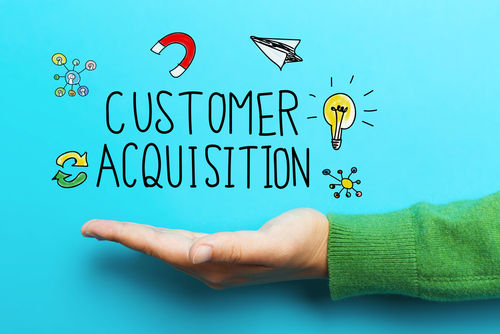 Reading Time: 4 minutes
Reading Time: 4 minutesOne of the most important and useful metrics to track in your business is Customer Acquisition Cost, or CAC. Put simply, it is the total cost of making a sale to a customer – from the initial introduction of the product, all the way to the concluding sale of goods or services. This knowledge, as you might imagine, is extremely useful for developing your business’s strategy as you grow. Rather than taking the “spray and pray” approach to marketing and advertising, online businesses can carefully track the costs and investment needed to turn potential customers into engaged, active, and happy clients.
Since the customer acquisition cost is a single number, it might seem on the surface to be quite an easy calculation. However, this number can be deceptively difficult to calculate accurately, and there are a number of pitfalls to be aware of when trying to figure out the CAC for your business. And there can be a lot riding on this number as well – customer acquisition costs can mean the difference between success or failure in any business, and they often hold great importance to investors.
Measuring CAC, First Steps
The CAC for a business will vary quite widely depending on the type of product or services sold, the intended market for them, and the expected rate of return for a customer once they have been converted. For example, let’s analyze a theoretical E-commerce company, which sells specialty products through Shopify or a similar outlet. They take out $10,000 in online advertising, and from the click-through of those ads, they have one thousand customers that go on to purchase something from their site. The cost to acquire these customers is thus 10,000/1,000 = $10 for each one.
There is a pitfall here though. Though the advertising cost $10k and we brought in 100 customers, online advertisements are likely not the only reason these sales were made. There may be other “softer” factors to consider – perhaps the company recently invested heavily into SEO and market research, or maybe there were other forms of advertising present before the advertising was purchased – blog posts, YouTube videos, etc. It can be very hard to separate the tangible expenditures from the more intangible (yet extremely important) ways in which the business invested, and thus the actual customer acquisition cost will often be higher than it seems.
Cost to Acquire Customers vs. Their Lifetime Value
Another factor to consider is that although CAC can be a reasonably accurate estimate of the cost to gain a customer, it doesn’t really go that far to explain the value of that customer in the long term. For this, we need to introduce another term, called Customer Lifetime Value, or CLV. This is a value that is derived by dividing generated sales revenue by the CAC, and it can be used to show the potential revenue that might be generated from a client after the true cost of getting their business.
In the case of our E-commerce shop, although some of this clientele may return again to shop and may eventually become a regular shopper, many of them will make a single purchase and not return. Additionally, many of these purchases may be quite small – which means that even though the CAC for our e-commerce business is fairly low, our potential CLV from them is not very high either.
Understanding Your Marketing Channels
One of the most important ways to understand the overall CAC value of your business is to track the individual CAC values for each area of your marketing strategy. Traditionally, this has been a difficult task for a business – if your business is running a multilevel campaign where each part of the advertisement supports the others, how can you really pinpoint the place where the conversion finally happened?
Online businesses, by contrast, have some excellent tools at their disposal to show where customers are most efficiently acquired. As an example, let’s pretend that we are running an online b2b company, which provides SaaS to digital marketing firms. For our marketing, we are using a combination of Facebook ads, Google AdWords, blog posts, pay-per-click advertisements, and a social media campaign.
For a non-online business, all these separate streams might be very difficult or even impossible to track. However, by using Google Analytics, it’s possible to not only track all the traffic generated to your site, but also track the destination that it came from. You can then correlate this data with sales data to get a very accurate picture of all your conversion-generating streams.
Small Streams Generate a Mighty River
Having extremely granular data like this is extremely powerful, because not only can you see which advertising streams are working – you can also see which streams have the lowest customer acquisition costs! This is a massive boon to your marketing strategy, because now, you may concentrate your efforts on the advertising zones which offer the most “bang for your buck.” Additionally, you can discover which advertising streams offer the best customer lifetime value, regardless of whether those are the areas with the lowest CAC.
The ability to optimize in this way is extremely important, because it offers the opportunity to lower your overall customer acquisition cost. Instead of taking the “blanket” approach to your online marketing, you can now accurately prioritize the areas of your strategy that offer truly productive returns, and de-emphasize those which have proven to be less fruitful. When you adjust your spending in this way, your overall CAC goes down for the entire business, and you are able to operate more efficiently.
Calculating the true customer acquisition cost of your business can seem a daunting task – but it doesn’t need to be. By using analytics tools and breaking your traffic origins down, it becomes possible to gain a clear picture of your CAC and use that info wisely to generate the best possible outcome for your business.
At Vizion Interactive, we have the expertise, experience, and enthusiasm to get results and keep clients happy! Learn more about how our status as a Google Partner, along with our PPC Management, Google Shopping Ads, Social Media Advertising, Amazon Advertising, and other Paid Media services can increase sales and boost your ROI. But don’t just take our word for it, check out what our clients have to say, along with our case studies.




